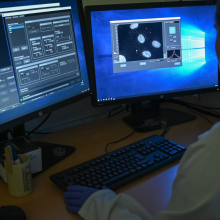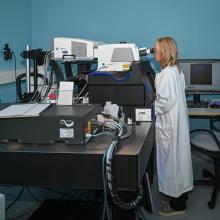Contact
Noëlle Mathieu

Launched in early 2019, to run for a duration of four years, the IXBONE project aims to develop a new cell therapy strategy to limit induced side effects on bone tissue following radiation therapy used in the treatment of cancers of the upper respiratory and digestive tracts. IXBONE receives funding from the ANR (Agence nationale de la recherche) obtained under the 2018 call for projects PRCE (Projet de recherche collaborative-Entreprise).
Project dates : 2019-2023
Budget : 500 k€ (ANR-PRCE funding)
Partners : RMeS Laboratory (Inserm-Université de Nantes-Oniris U1229), OTR3
Cancer of the upper aerodigestive tract (mouth, throat and larynx) is one of the most common cancers across the world, with more than 260,000 new cases reported each year. In France, squamous cell carcinoma accounts for 90% of cancers in ENT, and is the fourth most common type of cancer in men. When treated with radiotherapy, 5% of patients develop a serious side effect called mandibular osteoradionecrosis (ORN). Bone tissue irradiated at high doses no longer develops — more specifically, its development is arrested (hypoplasia) and is no longer irrigated by the blood system (ischemia). The blood supply being essential for bone homeostasis, bone tissue loses its capacity for regeneration. Over time, necrosis of the jaw can lead to fractures and serious disorders of swallowing and phonation (production of the sounds of spoken language). The best treatment currently available is autologous bone graft, using bone taken from the patient's own body, a procedure which remains problematic. Removing bone from anywhere in the body of a patient with chronic disease is a major and high-risk medical intervention.
Mesenchymal stromal cells (MSCs) have been used for over 20 years in cell therapy for their tissue repair capabilities. They release proteins that can act remotely on different tissue compartments. In particular, it has been shown that the injection of MSCs can decrease inflammation and stimulate osteoinduction (bone growth, or osteogenesis) following a fracture or injury. At the IRSN, their use has been the subject of research since the 2000s, aimed at mitigating the side effects of irradiation, for example in the abdominopelvic region following radiotherapy (the ANTHOS project) and in skin lesions after accidents (Cell Therapy Program).
The IXBONE project aims to develop a new treatment procedure based on a combination of matrix therapy and cell therapy, with the use of a combined injectable biomaterial (CIB) to help regenerate bone tissue in patients suffering from mandibular osteoradionecrosis. The therapeutic strategy explored consists of local injections of bone marrow MSCs protected by a hydrogel matrix (hydroxypropylmethyl-cellulose – HPMC) associated with synthetic molecules, RGTAs (Regenerating Agents), which improve the action of MSCs and increase their therapeutic efficacy. This principle of injection of MSCs protected by a hydrogel was used successfully in the ANTHOS project.
The IXBONE project is organized around four working groups (WGs) led by the different partners in the project. These are: the IRSN Laboratory of radiobiology of medical exposure (Laboratoire de radiobiologie des expositions médicales - LRMed), the Regenerative and skeletal medicine laboratory (Médecine régénératrice et squelette - RmeS (Inserm U1229, University of Nantes-Oniris)) and the biotechnology company OTR3.
The RmeS and OTR3 will together seek the formulation of the biomaterial presenting the best stability, kinetics of fixation and capacity for the release of RGTAs. This group will evaluate and modulate the concentration, viscosity, pH and other parameters of the formulations tested, first without MSCs in order to find a readily injectable form of the biomaterial which does not destroy the hydrogel matrix and which has the desired RGTA-release properties. MSCs will then be mixed with the biomaterial, and their viability tested in vitro (MTT assay of living cell counts) along with their capacity for osteoinduction, to confirm the best formulation for injection.
The RmeS laboratory and the LRMed laboratory of the IRSN will focus on an in vitro analysis of the ability of MSCs encapsulated in the biomaterial to secrete the active molecules as desired. In parallel, and based on the results obtained in vitro by WG 1, the researchers will test different formulations of the injectable biomaterial in vivo. After eight weeks, the therapeutic benefit on skull bone formation and the angiogenic process will be studied.
In a third the strand of research, the IRSN will evaluate one or two formulations having shown therapeutic properties (WG 2) on an in vivo preclinical rat model developed by the IRSN presenting with mandibular osteoradionecrosis. This model is representative of lesions that occur after radiotherapy. The researchers will evaluate the formation and structure of mandibular bone using a micro-scanner acquired by the IRSN, with which: X-ray microtomography allows 3D images of samples. The molecular and cellular processes involved (new vascularization, inflammation, migration of MSCs, etc.) will also be studied. The benefit of the injectable biomaterial will be compared between the treatment using the MSCs associated with the RGTA and the biomaterial, and treatment with biphasic calcium phosphate.
In a fourth and final strand, once the final formulation, the dose and the method of administration have been selected, OTR3 will develop a strategy for a future clinical trial including human patients suffering from mandibular ORN.
The IXBONE project should allow an effective therapeutic strategy to be proposed for patients developing mandibular ORN, through the development of the injectable biomaterial (CIB). In order to reach commercialization of the CIB, a clinical trial will need to be prepared at the end of the project.
Conclusive results will open new perspectives for cell therapy using MSCs in a biomaterial, facilitating their use in the clinical field for other types of bone regeneration as well as for other tissues.
Laboratories : LRMed - Medical exposure radiobiology laboratory

The aim of LRMed is to acquire new knowledge on the biological mechanisms of initiation and progression of localized lesions in healthy tissues resulting from exposure to ionizing radiation, at moderate and high doses, used in the medical field for diagnostic or therapeutic purposes (e.g. radiotherapy) to better predict the risks of complications, better understand, prevent and treat them.
Noëlle Mathieu